
“I’m Happy-Sad Today” by Lory Britain
 Have you ever felt two big feelings at the same time and been a bit confused? Maybe you felt excited, but nervous before your first sleepover? Or maybe when a friend told you they didn’t want to play, you felt sad and mad? Having two conflicting feelings is normal, but can be confusing to make sense of. In this lesson, Ms. Shaw is joined by special guest, Kitty, to talk all about the mixed-together feelings we can have and how to sort them out.
Have you ever felt two big feelings at the same time and been a bit confused? Maybe you felt excited, but nervous before your first sleepover? Or maybe when a friend told you they didn’t want to play, you felt sad and mad? Having two conflicting feelings is normal, but can be confusing to make sense of. In this lesson, Ms. Shaw is joined by special guest, Kitty, to talk all about the mixed-together feelings we can have and how to sort them out.
“In My Heart: A Book of Feelings” by Jo Witek
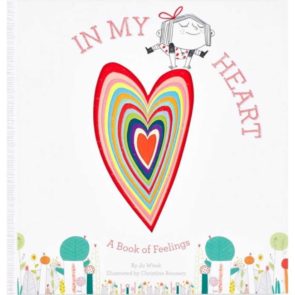 Our hearts can feel so many different feelings! Some make us happy, excited, or silly, while others make us sad, worried, or out of control. In this lesson, Ms. Shaw teaches students that all our feelings are okay (even the ones that don’t feel so good) and will come and go–just like the weather! This lesson also includes a simple art activity and “mindful moment” technique.
Our hearts can feel so many different feelings! Some make us happy, excited, or silly, while others make us sad, worried, or out of control. In this lesson, Ms. Shaw teaches students that all our feelings are okay (even the ones that don’t feel so good) and will come and go–just like the weather! This lesson also includes a simple art activity and “mindful moment” technique.
“How Are You Peeling?” by Saxton Freymann
 In this silly and lighthearted lesson, Ms. Shaw is joined by a special guest, Kitty! Kitty and Ms. Shaw talk about feelings by reading the book “How Are You Peeling?” They discuss body clues that let us know how someone else is feeling and practice a breathing technique to use to help us feel better when we’re having a bad day.
In this silly and lighthearted lesson, Ms. Shaw is joined by a special guest, Kitty! Kitty and Ms. Shaw talk about feelings by reading the book “How Are You Peeling?” They discuss body clues that let us know how someone else is feeling and practice a breathing technique to use to help us feel better when we’re having a bad day.
“Listening to My Body” by Gabi Garcia
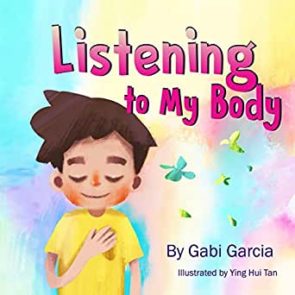 Our bodies give us so many messages! They tell us when we’re hungry, thirsty, cold, and tired. They even tell us how we’re feeling. It’s important to practice paying attention to our bodies so we know what we need. The more we practice listening to our bodies, the better we get at responding with care and kindness to ourselves! In this lesson, students practice identifying different bodily sensations and feelings by learning to pay attention to their heartbeat, breath, and more. The lesson also includes a “mindful moment” technique to practice sitting still and listening, as well a craft to make a calm down jar (directions here).
Our bodies give us so many messages! They tell us when we’re hungry, thirsty, cold, and tired. They even tell us how we’re feeling. It’s important to practice paying attention to our bodies so we know what we need. The more we practice listening to our bodies, the better we get at responding with care and kindness to ourselves! In this lesson, students practice identifying different bodily sensations and feelings by learning to pay attention to their heartbeat, breath, and more. The lesson also includes a “mindful moment” technique to practice sitting still and listening, as well a craft to make a calm down jar (directions here).
“My Incredible Talking Body” by Rebecca Bowen
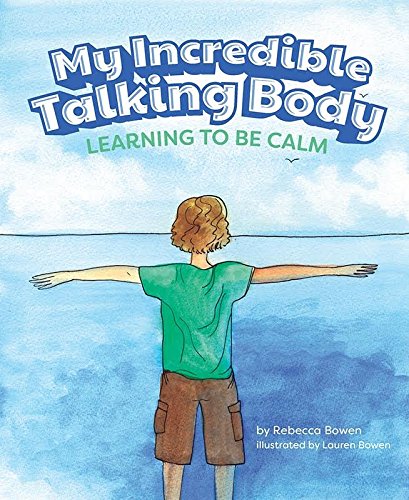 Learning to listen to the messages and signals our bodies send us helps children begin to identify their feelings and respond accordingly. In this lesson, Ms. Shaw reads the story, “My Incredible Talking Body,” which teaches children the common physical signs our bodies give us when we’re experiencing a big feeling (i.e., fast heartbeat, hot face, irregular breathing, etc.). This lesson also includes a Body Feelings activity for students to practice identifying which bodily sensations correspond with different feelings. Finally, this lesson models a “mindful moment” breathing technique to use to regulate our breath.
Learning to listen to the messages and signals our bodies send us helps children begin to identify their feelings and respond accordingly. In this lesson, Ms. Shaw reads the story, “My Incredible Talking Body,” which teaches children the common physical signs our bodies give us when we’re experiencing a big feeling (i.e., fast heartbeat, hot face, irregular breathing, etc.). This lesson also includes a Body Feelings activity for students to practice identifying which bodily sensations correspond with different feelings. Finally, this lesson models a “mindful moment” breathing technique to use to regulate our breath.
“Marcy’s Having All The Feels” by Allison Edwards
 In this lesson, Ms. Shaw reads a story about a girl who just doesn’t want to feel all the feels! Marcy likes feeling happy, but doesn’t like the experience of uncomfortable feelings, such as anger, sadness, worry, and jealousy. However, when all of her feelings suddenly disappear, she learns the important lesson that all of our feelings–even the uncomfortable ones–are helpful to us and an important part of being human. Ms. Shaw teaches students to notice their feelings as they come and go, paying special attention to their intensity or strength. How you respond when you’re feeling angry at a level 9 or 10 will be different than when you’re at a 2 or 3. You can create a Feelings Thermometer (like the one Ms. Shaw shows) to help you practice identifying how strong of a feeling you’re experiencing.
In this lesson, Ms. Shaw reads a story about a girl who just doesn’t want to feel all the feels! Marcy likes feeling happy, but doesn’t like the experience of uncomfortable feelings, such as anger, sadness, worry, and jealousy. However, when all of her feelings suddenly disappear, she learns the important lesson that all of our feelings–even the uncomfortable ones–are helpful to us and an important part of being human. Ms. Shaw teaches students to notice their feelings as they come and go, paying special attention to their intensity or strength. How you respond when you’re feeling angry at a level 9 or 10 will be different than when you’re at a 2 or 3. You can create a Feelings Thermometer (like the one Ms. Shaw shows) to help you practice identifying how strong of a feeling you’re experiencing.
“A Little Spot of Feelings” by Diane Alber
 We can feel so many feelings! In this lesson, explore just a few of the common feelings we experience by learning about visual body clues that reveal how someone is feeling. Students can also download and print a Feelings Poster to expand their feelings vocabulary as well as a Feelings Book to journal about feelings they experience. Ms. Shaw also leads students through a “mindful moment” to reflect on things in life that change (i.e., feelings!) versus things that stay the same.
We can feel so many feelings! In this lesson, explore just a few of the common feelings we experience by learning about visual body clues that reveal how someone is feeling. Students can also download and print a Feelings Poster to expand their feelings vocabulary as well as a Feelings Book to journal about feelings they experience. Ms. Shaw also leads students through a “mindful moment” to reflect on things in life that change (i.e., feelings!) versus things that stay the same.

“Even Superheroes Have Bad Days” by Shelly Becker
 Everyone has bad days! Even superheroes. In this lesson, Ms. Shaw talks about coping with bad days and big feelings. She encourages students to make their own “feel better” or “calm down” boxes with supplies to help them feel better. These boxes are great for all ages and really anything can go in them–whatever is distracting, calming, or makes you feel better! Ms. Shaw shows students some ideas of things that might go in one. Ideas include: a timer, glitter/sensory jars, paper and pens for journaling or drawing, coloring pages, clay/putty, yoga or movement cards, and more!
Everyone has bad days! Even superheroes. In this lesson, Ms. Shaw talks about coping with bad days and big feelings. She encourages students to make their own “feel better” or “calm down” boxes with supplies to help them feel better. These boxes are great for all ages and really anything can go in them–whatever is distracting, calming, or makes you feel better! Ms. Shaw shows students some ideas of things that might go in one. Ideas include: a timer, glitter/sensory jars, paper and pens for journaling or drawing, coloring pages, clay/putty, yoga or movement cards, and more!
“The Three Little Yogis and The Wolf Who Lost His Breath” by Susan Verde
 We’re all familiar with the classic, “The Three Little Pigs and The Big Bad Wolf,” but what if the wolf wanted to learn how to calm down and take care of his feelings instead of destroying houses? That’s just what happens in this sweet story! Three yogi pigs take the wolf on a journey that teaches him how to use his breath and yoga to calm down and feel better. In this lesson, students are also invited to complete the activity sheets from the book, including a fun invent your own calm down yoga pose challenge!
We’re all familiar with the classic, “The Three Little Pigs and The Big Bad Wolf,” but what if the wolf wanted to learn how to calm down and take care of his feelings instead of destroying houses? That’s just what happens in this sweet story! Three yogi pigs take the wolf on a journey that teaches him how to use his breath and yoga to calm down and feel better. In this lesson, students are also invited to complete the activity sheets from the book, including a fun invent your own calm down yoga pose challenge!
“Breathing Makes It Better” by Christopher Willard and Wendy O’Leary
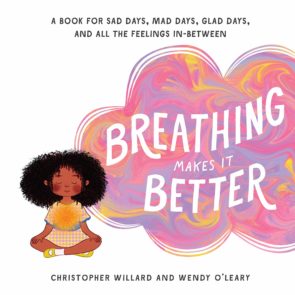 In this lesson, Ms. Shaw talks all about a very important self-regulation skill: breathing! Breathing helps us slow down and pay attention to the present moment, so we can understand how we’re feeling. The story, “Breathing Makes It Better,” teaches children to breathe through their feelings and find calm with recurring cues to “stop and take a breath”. This lesson also includes a “mindful moment” technique and teaches three simple breathing strategies students can do at home.
In this lesson, Ms. Shaw talks all about a very important self-regulation skill: breathing! Breathing helps us slow down and pay attention to the present moment, so we can understand how we’re feeling. The story, “Breathing Makes It Better,” teaches children to breathe through their feelings and find calm with recurring cues to “stop and take a breath”. This lesson also includes a “mindful moment” technique and teaches three simple breathing strategies students can do at home.
“Some Days I Flip My Lid” by Kellie Bailey and Hannah Bailey
 Learning to be a calm and cool kid takes lots of practice! In this lesson, Ms. Shaw teaches students about the brain and what it means to “flip your lid”. When we’re upset and “flip our lid,” our “upstairs brain,” which helps us think and make good choices, gets overpowered by our “downstairs brain,” which is ruled by our strong feelings and impulses. Ms. Shaw teaches students that taking mindful breaths can help us stay in control and not flip our lid. Ms. Shaw also models a “mindful moment” students can use when they’re angry.
Learning to be a calm and cool kid takes lots of practice! In this lesson, Ms. Shaw teaches students about the brain and what it means to “flip your lid”. When we’re upset and “flip our lid,” our “upstairs brain,” which helps us think and make good choices, gets overpowered by our “downstairs brain,” which is ruled by our strong feelings and impulses. Ms. Shaw teaches students that taking mindful breaths can help us stay in control and not flip our lid. Ms. Shaw also models a “mindful moment” students can use when they’re angry.
“Rosie’s Brain” by Linda Ryden
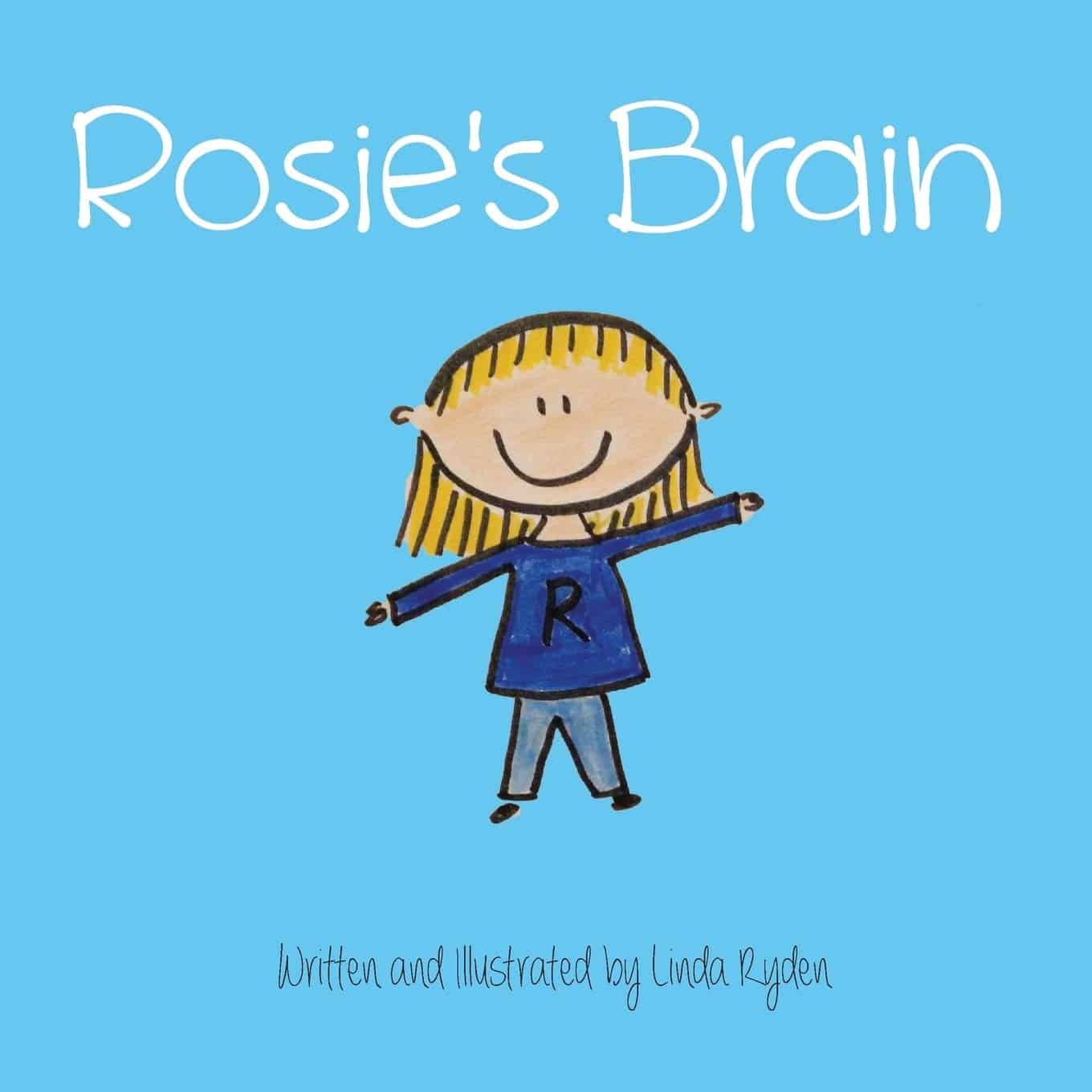 In this lesson, Ms. Shaw teaches students about three parts of the brain: the prefrontal cortex, hippocampus, and amygdala. Students learn what each of these parts of the brain do and the role they play in our emotions and calming down. Ms. Shaw also talks about what it means to “flip your lid” (see the attached brain poster) and uses a pinwheel to demonstrate how taking slow, deep breaths helps us to calm down and regulate our feelings. Feel free to download this DIY pinwheel to make your very own!
In this lesson, Ms. Shaw teaches students about three parts of the brain: the prefrontal cortex, hippocampus, and amygdala. Students learn what each of these parts of the brain do and the role they play in our emotions and calming down. Ms. Shaw also talks about what it means to “flip your lid” (see the attached brain poster) and uses a pinwheel to demonstrate how taking slow, deep breaths helps us to calm down and regulate our feelings. Feel free to download this DIY pinwheel to make your very own!
“I Am Yoga” by Susan Verde
 In this lesson, Ms. Shaw reads a short story about the magic of yoga! Yoga can be fun and imaginative. It helps us focus and get to calm. Yoga can even help us to feel happy and safe in our bodies. Ms. Shaw also teaches six playful yoga poses and models a “mindful moment” technique to help practice slow, controlled breathing.
In this lesson, Ms. Shaw reads a short story about the magic of yoga! Yoga can be fun and imaginative. It helps us focus and get to calm. Yoga can even help us to feel happy and safe in our bodies. Ms. Shaw also teaches six playful yoga poses and models a “mindful moment” technique to help practice slow, controlled breathing.
“A Little Calm Spot” by Diane Alber

Sometimes when your emotions get too big, it’s hard to stay calm! In this lesson, Ms. Shaw reads “A Little Calm Spot,” a story about how using breathing, a positive mindset, and movement (yoga) can help us overcome some of our biggest emotions. Ms. Shaw also teaches students six yoga poses they can do to feel better. This lesson also includes a “mindful moment” which you can download here.
“The Yoga Dragon” by Steve Herman
 In this lesson, Ms. Shaw reads a sweet story about a dragon who learns to keep his cool by practicing yoga. This is a wonderful story that illustrates to younger children how yoga can strengthen our bodies and also calm our minds. Ms. Shaw teaches five yoga simple poses students can use to help get the tension out of their bodies and begin to feel better.
In this lesson, Ms. Shaw reads a sweet story about a dragon who learns to keep his cool by practicing yoga. This is a wonderful story that illustrates to younger children how yoga can strengthen our bodies and also calm our minds. Ms. Shaw teaches five yoga simple poses students can use to help get the tension out of their bodies and begin to feel better.
“Angry Ninja” by Mary Nhin
 We all get upset and angry from time to time. It’s a completely normal feeling! But having some tools in our “calm down toolbox” to help us feel better sure is helpful! In this lesson, Ms. Shaw reads “Angry Ninja,” which teaches children a wonderful calm down strategy called the 1+3+10 Strategy. This is a super simple yet powerful strategy for children to use to cope with their big feelings. Ms. Shaw also models a “mindful moment” with a pinwheel. Feel free to download this DIY pinwheel to make your very own!
We all get upset and angry from time to time. It’s a completely normal feeling! But having some tools in our “calm down toolbox” to help us feel better sure is helpful! In this lesson, Ms. Shaw reads “Angry Ninja,” which teaches children a wonderful calm down strategy called the 1+3+10 Strategy. This is a super simple yet powerful strategy for children to use to cope with their big feelings. Ms. Shaw also models a “mindful moment” with a pinwheel. Feel free to download this DIY pinwheel to make your very own!
“Happy Right Now” by Julie Berry
 It was cloudy and rainy when Ms. Shaw and her dog, Tino, woke up this morning. They were both feeling sad and disappointed that they couldn’t go on a long walk… That is until they realized that they have the power to choose to be happy! Ms. Shaw and Tino decide to have a dance party to “Happy” by Pharrell Williams. Ms. Shaw also reads the book, “Happy Right Now,” which teaches children how to be happy in the moment and embrace things as they are. This lesson also includes a breathing strategy and “mindful moment” technique on “planting seeds of happiness”.
It was cloudy and rainy when Ms. Shaw and her dog, Tino, woke up this morning. They were both feeling sad and disappointed that they couldn’t go on a long walk… That is until they realized that they have the power to choose to be happy! Ms. Shaw and Tino decide to have a dance party to “Happy” by Pharrell Williams. Ms. Shaw also reads the book, “Happy Right Now,” which teaches children how to be happy in the moment and embrace things as they are. This lesson also includes a breathing strategy and “mindful moment” technique on “planting seeds of happiness”.
“Worry Says What?” by Allison Edwards
 In this lesson, Ms. Shaw talks about worry. Feeling worried is a normal and even adaptive feeling, but sometimes our worries hold us back from doing things we want to do. Ms. Shaw reads the story, “Worry Says What?” which teaches students to flip their thinking when anxious thoughts begin and turn them into powerful reminders of all they are capable of accomplishing. Students can also download and print their own “Worry Says… I Say” pages to practice thinking of things they can say to “talk back” to their worries.
In this lesson, Ms. Shaw talks about worry. Feeling worried is a normal and even adaptive feeling, but sometimes our worries hold us back from doing things we want to do. Ms. Shaw reads the story, “Worry Says What?” which teaches students to flip their thinking when anxious thoughts begin and turn them into powerful reminders of all they are capable of accomplishing. Students can also download and print their own “Worry Says… I Say” pages to practice thinking of things they can say to “talk back” to their worries.
“Find Your Calm” by Gabi Garcia
 In this lesson, Ms. Shaw talks about things we can do when we are having anxious and worried feelings by reading the story “Find Your Calm.” This story teaches children how to tap into their sense of safety when anxiety sends a false alarm, so they can find their calm. Ms. Shaw also teaches students a grounding strategy they can use when they’re feeling worried or anxious to help pull them out of the worry and into the present moment. You can download and print a handout of this grounding strategy here.
In this lesson, Ms. Shaw talks about things we can do when we are having anxious and worried feelings by reading the story “Find Your Calm.” This story teaches children how to tap into their sense of safety when anxiety sends a false alarm, so they can find their calm. Ms. Shaw also teaches students a grounding strategy they can use when they’re feeling worried or anxious to help pull them out of the worry and into the present moment. You can download and print a handout of this grounding strategy here.